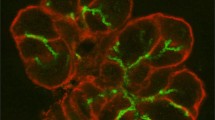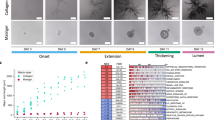Abstract
Normal hollow epithelial acini are 3-dimensional culture structures that resemble the architecture and functions of normal breast glands and lobules. This experimental model enables in vitro investigations of genotypic and molecular abnormalities associated with epithelial cancers. However, the way in which the acinar structure is formed is not yet completely understood. Gaining more information about consecutive stages of acini development—starting from a single cell that gives rise to a cluster of randomly oriented cells, followed by cell differentiation that leads to a layer of polarised cells enclosing the hollow lumen—will provide insight into the transformations of eukaryotic cells that are necessary for their successful arrangement into an epithelium. In this paper, we introduce a two-dimensional single-cell-based model representing the cross section of a typical acinus. Using this model, we investigate mechanisms that lead to the unpolarised cell growth, cell polarisation, stabilisation of the acinar structure and maintenance of the hollow lumen and discuss the sufficient conditions for each stage of acinar formation. In the follow-up paper (Rejniak and Anderson, A computational study of the development of epithelial acini. II. Necessary conditions for structure and lumen stability), we investigate what morphological changes are observable in the growing acini when some assumptions of this model are relaxed.
Similar content being viewed by others
References
Alberts, B., Johnson, A., Lewis, J., Raff, M., Roberts, K., Walter, P., 2002. Molecular biology of the cell. Garland Science, 4th edn.
Anderson, A.R.A., 2005. A hybrid mathematical model of solid tumour invasion: the importance of cell adhesion. Math. Med. Biol. 22, 163–186.
Anderson, A.R.A., Weaver, A.M., Cummings, P.T., Quaranta, V., 2006. Tumor morphology and phenotypic evolution driven by selective pressure from the microenvironment. Cell 127, 905–915.
Ardens, M.J., Wyllie, A.H., 1991. Apoptosis: mechanisms and roles in pathology. Int. Rev. Exp. Pathol. 32, 223–254.
Bowen, I.D., Lockshin, R.A., 1981. Cell Death in Biology and Pathology. Kluwer Academic, Dordercht.
Debnath, J., Brugge, J.S., 2005. Modelling glandular epithelial cancers in three-dimensional cultures. Nat. Rev. Cancer 5, 675–688.
Debnath, J., Mills, K.R., Collins, N.L., Reginato, M.J., Muthuswamy, S.K., Brugge, J.S., 2002. The role of apoptosis in creating and maintaining luminal space within normal and oncogene-expressing mammary acini. Cell 111, 29–40.
Debnath, J., Muthuswamy, S.K., Brugge, J.S., 2003. Morphogenesis and oncogenesis on MCF-10A mammary epithelial acini grown in three-dimensional basement membrane cultures. Methods 30, 256–268.
Dembo, M., Harlow, F., 1986. Cell motion, contractile networks, and the physics of interpenetrating reactive flow. Biophys. J. 50, 109–121.
Dillon, R., Othmer, H.G., 1999. A mathematical model for outgrowth and spatial pattering of the vertebrate limb bud. J. Theor. Biol. 197, 295–330.
Ferguson, D.J.P., 1985. Ultrastructural characterisation of the proliferative (stem?) cells within the parenchyma of the normal “resting” breast. Virchows Arch. Pathol. Anat. 407, 379–385.
Ferguson, D.J.P., 1988. An ultrastructural study of mitosis and cytokinesis in normal “resting” human breast. Cell Tissue Res. 252, 581–587.
Ferguson, D.J.P., Anderson, T.J., 1981. Ultrastructural observations on cell death by apoptosis in the “resting” human breast. Virchows Arch. Pathol. Anat. 393, 193–203.
Laurent, V.M., Planus, E., Fodil, R., Isabey, D., 2003. Mechanical assessment by magnetocytometry of the cytosolic and cortical cytoskeletal compartments in adherent epithelial cells. Biorheology 40, 235–240.
Mills Shaw, K.R., Wrobel, C.N., Brugge, J.S., 2004. Use of three-dimensional basement membrane cultures to model oncogene-induced changes in mammary epithelial morphogenesis. J. Mammary Gland Biol. Neoplasia 9, 297–310.
Nelson, C.M., Bissell, M.J., 2005. Modeling dynamic reciprocity: engineering three-dimensional culture models of breast architecture, function, and neoplastic transformation. Semin. Cancer Biol. 15, 342–352.
Nelson, W.J., 2003. Adaptation of core mechanisms to generate cell polarity. Nature 422, 766–774.
O’Brien, L.E., Zegers, M.M.P., Mostov, K.E., 2002. Building epithelial architecture: insights from three-dimensional culture models. Nat. Rev. Mol. Cell Biol. 3, 531–537.
Peskin, C.S., 1972. Flow patterns around heart valves: a numerical method. J. Comput. Phys. 10, 252–271.
Peskin, C.S., 1977. Numerical analysis of blood flow in the heart. J. Comput. Phys. 25, 220–252.
Peskin, C.S., 2002. The immersed boundary method. Acta Numer. 11, 479–517.
Rejniak, K.A., 2002. A computational model of the mechanics of growth of a trophoblast tissue. PhD thesis, Tulane University.
Rejniak, K.A., 2005. A single-cell approach in modeling the dynamics of tumor microregions. Math. Biosci. Eng. 2, 643–655.
Rejniak, K.A., 2007a. An immersed boundary framework for modelling the growth of individual cells: an application to the early tumour development. J. Theor. Biology 247, 186–204.
Rejniak, K.A., 2007b. Modelling the development of complex tissues using individual viscoelastic cells. In: A.R.A. Anderson, M.A.J. Chaplain, K.A. Rejniak (Eds.), Single Cell Based Models in Biology and Medicine. Birkhäuser, Basel
Rejniak, K.A., Anderson, A.R.A., 2007. A computational study of the development of epithelial acini. II. Necessary conditions for structure and lumen stability, in preparation.
Rejniak, K.A., Dillon, R.H., 2007. A single cell based model of the ductal tumor microarchitecture. Comput. Math. Methods Med. 8(1), 51–69.
Rejniak, K.A., Kliman, H.J., Fauci, L.J., 2004. A computational model of the mechanics of growth of the villous trophoblast bilayer. Bull. Math. Biol. 66, 199–232.
Wang, A.Z., Ojakian, G.K., Nelson, W.J., 1990a. Steps in the morphogenesis of a polarised epithelium I. Uncoupling the roles of cell–cell and cell-substratum contact in establishing plasma membrane polarity in multicellular epithelial (MDCK) cysts. J. Cell Sci. 95, 137–151.
Wang, A.Z., Ojakian, G.K., Nelson, W.J., 1990b. Steps in the morphogenesis of a polarised epithelium II. Disassembly and assembly of plasma membrane domains during reversal of epithelial cell polarity in multicellular epithelial (MDCK) cysts. J. Cell Sci. 95, 153–165.
Author information
Authors and Affiliations
Corresponding author
Rights and permissions
About this article
Cite this article
Rejniak, K.A., Anderson, A.R.A. A Computational Study of the Development of Epithelial Acini: I. Sufficient Conditions for the Formation of a Hollow Structure. Bull. Math. Biol. 70, 677–712 (2008). https://doi.org/10.1007/s11538-007-9274-1
Received:
Accepted:
Published:
Issue Date:
DOI: https://doi.org/10.1007/s11538-007-9274-1




